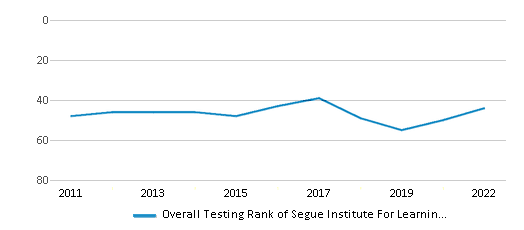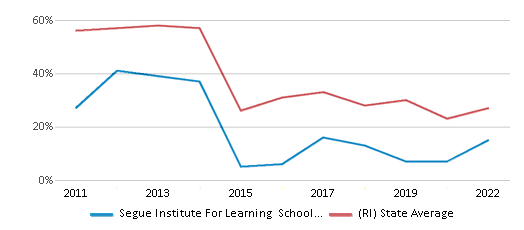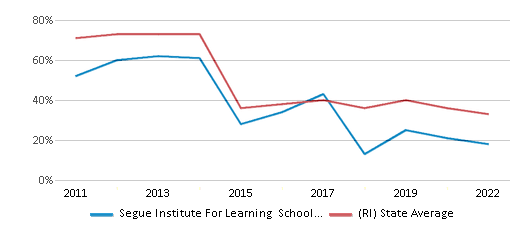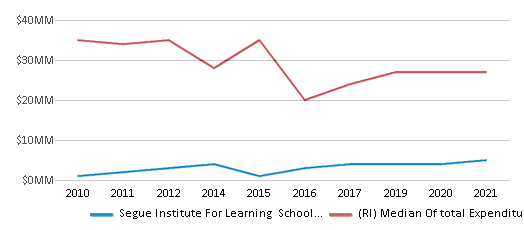For the 2025 school year, there are 2 public charter schools serving 358 students in Segue Institute For Learning School District. This district's average charter testing ranking is 5/10, which is in the bottom 50% of public charter schools in Rhode Island.
Public Charter Schools in Segue Institute For Learning School District have an average math proficiency score of 15% (versus the Rhode Island public charter school average of 20%), and reading proficiency score of 18% (versus the 25% statewide average).
Minority enrollment is 95% of the student body (majority Hispanic), which is more than the Rhode Island public charter school average of 86% (majority Hispanic).
Overview
This School District
This State (RI)
# Schools
2 Schools
43 Schools
# Students
358 Students
12,824 Students
# Teachers
24 Teachers
976 Teachers
Student : Teacher Ratio
15:1
15:1
District Rank
Segue Institute For Learning School District, which is ranked within the bottom 50% of all 62 school districts in Rhode Island (based off of combined math and reading proficiency testing data) for the 2021-2022 school year.
Overall District Rank
#44 out of 63 school districts
(Bottom 50%)
(Bottom 50%)

Math Test Scores (% Proficient)
15%
27%

Reading/Language Arts Test Scores (% Proficient)
18%
33%

Science Test Scores (% Proficient)
6-9%
31%

Students by Ethnicity:
Diversity Score
0.15
0.57
# American Indian Students
n/a
81 Students
% American Indian Students
n/a
1%
# Asian Students
n/a
245 Students
% Asian Students
n/a
2%
# Hispanic Students
329 Students
7,942 Students
% Hispanic Students
92%
62%
# Black Students
11 Students
2,259 Students
% Black Students
3%
18%
# White Students
18 Students
1,839 Students
% White Students
5%
14%
# Hawaiian Students
n/a
18 Students
% Hawaiian Students
n/a
n/a
# Two or more races Students
n/a
413 Students
% of Two or more races Students
n/a
3%
Students by Grade:
# Students in PK Grade:
-
24
# Students in K Grade:
40
1,111
# Students in 1st Grade:
39
1,115
# Students in 2nd Grade:
40
1,133
# Students in 3rd Grade:
37
1,121
# Students in 4th Grade:
40
977
# Students in 5th Grade:
40
1,048
# Students in 6th Grade:
41
1,030
# Students in 7th Grade:
41
946
# Students in 8th Grade:
40
937
# Students in 9th Grade:
-
970
# Students in 10th Grade:
-
867
# Students in 11th Grade:
-
846
# Students in 12th Grade:
-
699
# Ungraded Students:
-
-
District Revenue and Spending
The revenue/student of $15,559 in this school district is less than the state median of $22,250. The school district revenue/student has declined by 35% over four school years.
The school district's spending/student of $14,849 is less than the state median of $21,467. The school district spending/student has declined by 35% over four school years.
Total Revenue
$6 MM
$2,998 MM

Spending
$5 MM
$2,892 MM

Revenue / Student
$15,559
$22,250

Spending / Student
$14,849
$21,467

Best Segue Institute For Learning School District Public Charter Schools (2025)
School
(Math and Reading Proficiency)
(Math and Reading Proficiency)
Location
Grades
Students
Rank: #11.
Segue Inst For Learning
Charter School
(Math: 15% | Reading: 18%)
Rank:
Rank:
3/
Bottom 50%10
325 Cowden Street
Central Falls, RI 02863
(401) 721-0964
Central Falls, RI 02863
(401) 721-0964
Grades: K-8
| 358 students
Rank: n/an/a
Segue Institute Learning High School
Charter School
325 Cowden Street
Central Falls, RI 02863
(401) 721-0964
Central Falls, RI 02863
(401) 721-0964
Grades: n/a
| n/a students
Recent Articles

Year-Round Or Traditional Schedule?
Which is more appropriate for your child? A year-round attendance schedule or traditional schedule? We look at the pros and cons.

Why You Should Encourage Your Child to Join a Sports Team
Participating in team sports has a great many benefits for children, there is no doubt. In this article you will learn what those benefits are.

White Students are Now the Minority in U.S. Public Schools
Increasing birth rates among immigrant families from Asia and Central and South America, combined with lower birth rates among white families, means that for the first time in history, public school students in the United States are majority-minority. This shift in demographics poses difficulties for schools as they work to accommodate children of varying language abilities and socio-economic backgrounds.





